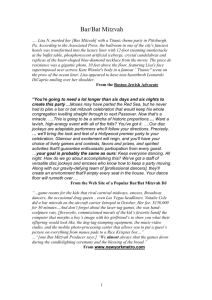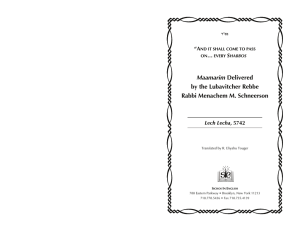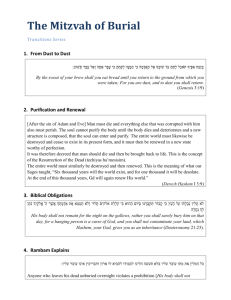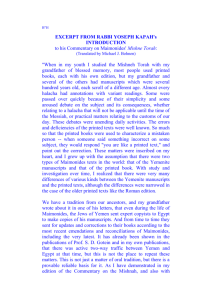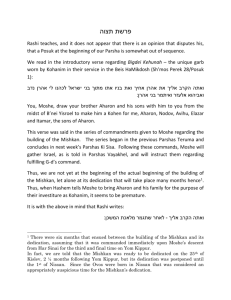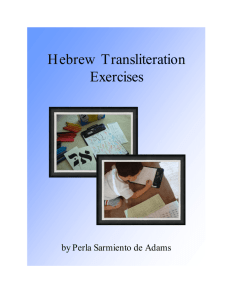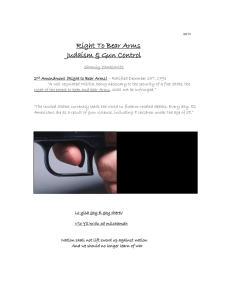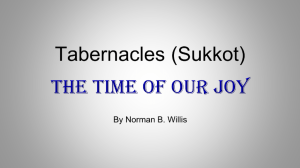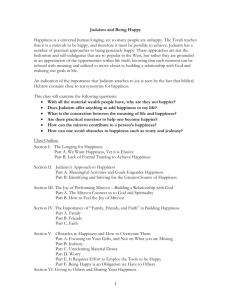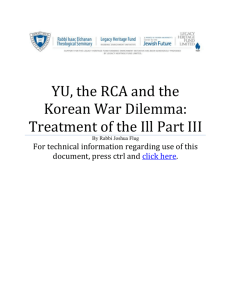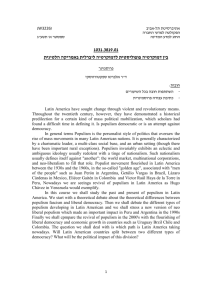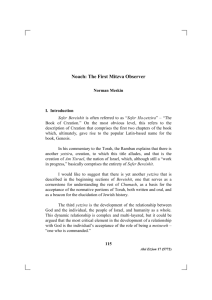Israel In Our Lives - Jewish Reconstructionist Community
advertisement
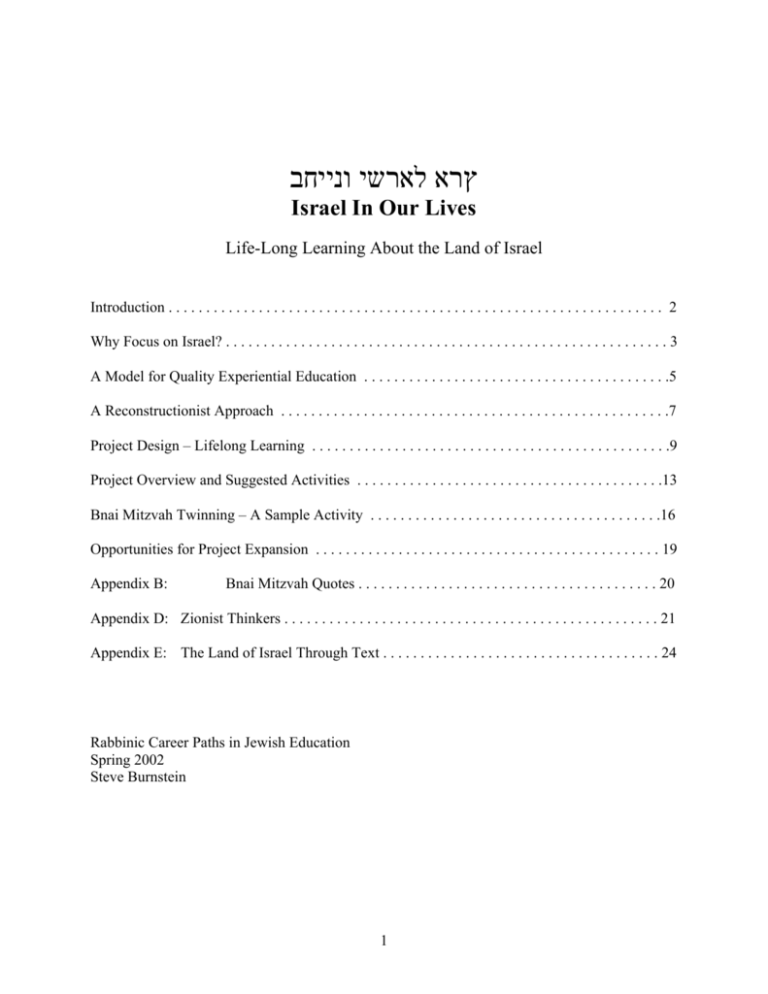
ץרא לארשי ונייחב Israel In Our Lives Life-Long Learning About the Land of Israel Introduction . . . . . . . . . . . . . . . . . . . . . . . . . . . . . . . . . . . . . . . . . . . . . . . . . . . . . . . . . . . . . . . . . . 2 Why Focus on Israel? . . . . . . . . . . . . . . . . . . . . . . . . . . . . . . . . . . . . . . . . . . . . . . . . . . . . . . . . . . . 3 A Model for Quality Experiential Education . . . . . . . . . . . . . . . . . . . . . . . . . . . . . . . . . . . . . . . . .5 A Reconstructionist Approach . . . . . . . . . . . . . . . . . . . . . . . . . . . . . . . . . . . . . . . . . . . . . . . . . . . .7 Project Design – Lifelong Learning . . . . . . . . . . . . . . . . . . . . . . . . . . . . . . . . . . . . . . . . . . . . . . . .9 Project Overview and Suggested Activities . . . . . . . . . . . . . . . . . . . . . . . . . . . . . . . . . . . . . . . . .13 Bnai Mitzvah Twinning – A Sample Activity . . . . . . . . . . . . . . . . . . . . . . . . . . . . . . . . . . . . . . .16 Opportunities for Project Expansion . . . . . . . . . . . . . . . . . . . . . . . . . . . . . . . . . . . . . . . . . . . . . . 19 Appendix B: Bnai Mitzvah Quotes . . . . . . . . . . . . . . . . . . . . . . . . . . . . . . . . . . . . . . . . 20 Appendix D: Zionist Thinkers . . . . . . . . . . . . . . . . . . . . . . . . . . . . . . . . . . . . . . . . . . . . . . . . . . 21 Appendix E: The Land of Israel Through Text . . . . . . . . . . . . . . . . . . . . . . . . . . . . . . . . . . . . . 24 Rabbinic Career Paths in Jewish Education Spring 2002 Steve Burnstein 1 Introduction Many of my strongest memories of synagogue, Judaism and Jewish education center around Israel. I remember preparing elaborate floats for the annual community Israel Independence Day celebration; being energized by the enthusiasm of the Israeli Scouts; seeing the blue JNF Tzedakah box proudly displayed in Jewish owned stores and in the homes of my family and friends; meeting and hosting Shlichim (emissaries) and exchange students from Israel; seeing photos and hearing stories from my grandparents, cousins, sister, father and brother after their visits to Israel; and, anxiously waiting until I would be old enough to go to Israel. For many of my generation Israel became an exotic, exciting, mystical and spiritual place where the collective soul of the Jewish people resided. A place that somehow seemed just a bit closer to God than Kansas City. The first generation in 2000 years to live with a vibrant Jewish State in Israel, every subject we learned in “Hebrew School” somehow connected to this magical place. The stories of the Torah and Holidays take place there. Hebrew is spoken there. Prayers express our yearning to return there. For us, Israel is the spiritual and cultural center of Judaism and the Jewish people. Israel embodies Kaplan’s and others’ dreams. Ahavat Tzion, Love of Zion, is an integral part of our Jewish identity – and a rallying point and source of tremendous pride for the world Jewish community. The purpose of this project is to help us discover and explore the centrality of the Land of Israel in our lives as Jews. This does not mean to say that Israel is the only place one may legitimately choose to live a Jewish life. Nor does it mean we cannot be critical of particular policies and actions of the Israeli Government. But this project does seek to provide a framework and system for developing a deeper connection, understanding and love of the Land of Israel. To 2 teach about Israel means to confront the anxieties, hostility, confusion and disappointment we often feel with the State of Israel. However, before we deal with these feelings, I believe we must first teach a love for the Land of Israel. In this way we can approach our issues and concerns regarding the modern state and political challenges from a loving and compassionate perspective, appreciating the symbolic, historical and spiritual meaning that Israel can provide. 3 Why Focus on Israel? The Land of Israel is inseparable from Jewish life. You can take the Jew out of the Land, but you can’t take the Land out of Judaism or the Jew. Several times each day Israel comes up in our prayers. We pray for the rebuilding of Jerusalem. We pray for peace in Israel. We pray for the restoration of Zion. Our Jewish consciousness cannot remain a Jewish consciousness if we exclude Israel from our thoughts and deeds.1 Many of us have difficulty with the traditional reading for the second paragraph of the Shema because of the supernatural theology if offers. We may therefore miss the deep connection reflected to the Land of Israel. If you truly listen to my biddings, as I bid you now – loving The Fount of Life, your God, and serving God with all your heart, with every breath – then I will give you rain upon your land in its appointed time, the early rain and later rain, so you may gather in your new grain, wine, and oil. Deuteronomy 11:14 The “land” here is Eretz Yisrael, the Land of Israel, the collective land of the Jewish people. Israel is the direction we pray. Israel is the spiritual, historical, and cultural center of the Jewish people. Jews all over the world add a special prayer during the winter months for rain in Israel. Even in the Diaspora, Jews have always lived according to the calendar of Israel, celebrating the spring and harvest when Israel celebrated its spring and harvest. When we gather in the grain, wine and oil mentioned above, we are harvesting three of the seven species.2 Every Shabbat and Holiday Jews all over the world light candles (oil), bless wine (grapevine), and give thanks for “bringing bread from the earth” (wheat – new grain). When we recite these blessings we join Jews from all times and places in the affirmation of our connection to the Land of Israel. 1 Teutsch, David. “Israel and the Diaspora: A Reconstructionist Reconsideration of Zionism.” p. 48-54. The Reconstructionist. Volume 62, #2, Spring 1998. 2 Seven Species indigenous to the Land of Israel which appear frequently in the Bible, liturgy and ritual. A land of wheat and barley, of vines, figs, and pomegranates, a land of olive oil and honey. Deuteronomy 8:8 4 Eretz Yisrael is not merely a piece of land. Rather, it is the heart and soul of 3000 years of Jewish history. Were Judaism rooted in Antarctica, every Friday evening Jews all over the world might bless the snow and ice. However, we say: . המוצא לחם מן הארץ. . . להדליק נר של שבת. . .בורא פרי הגן Because our Jewish roots, no matter where we live, are in the Land of Israel. 5 A Model for Quality Experiential Education Beginning in 1995, I had the opportunity to be part of an innovative experiential educational project called Pinat Shorashim3. Located at Kibbutz Gezer (adjacent to the Biblical site of Tel Gezer), Pinat Shorashim is a Biblical park and garden built by learners to be used by future learners. A process of learning which incorporates a unique combination of text study and Jewish educational construction work, participants explore and create the texture of Jewish text. For example, participants studying the Passover story built an obstacle course depicting the Exodus from Egypt (see Appendix A) including a mosaic design of Joseph’s Coat of Many Colors, pyramids, a balance beam depicting the ten plagues and other components. Other areas in the park, also built by program participants, include: the Isaiah Sculpture Garden, Paths of the Seven and Four Species, an Outdoor Sanctuary, Havdalah Herb Garden, Biblical Wine Press, Creation Sand Garden, and others. Over the last ten years thousands of people studied and built in Pinat Shorashim – each group benefiting from the efforts of those who worked before them. At the same time, they created new areas which become a rich source of learning for future participants. Whether kinesthetic, visual, or auditory learners – participants enjoyed activities designed to meet their needs and bring out their strengths. The success of the project is measured not only by the transmission of information – but by the synthesis of that information and the creation of Jewish memories. My involvement with this project taught me, in a concrete way, the importance of multisensory, creative and fun education for learners of all ages. It reminded me that the techniques we take for granted when working in early childhood education can tremendously enhance the success of adult learners as well. This creative, hands-on approach is the model for much of what 3 Additional background on Pinat Shorashim is available at www.pinatshorashim.org.il. 6 is contained in this document. Israel in Our Lives incorporates music, text storytelling, art, and drama in order to provide a variety of learning opportunities to meet assorted learning styles. 7 A Reconstructionist Approach In many ways, “secular” Israel is the embodiment of Kaplan’s philosophy and dream of Judaism as an evolving civilization - where tradition has a vote, but not a veto. Religion and culture are inseparably linked in Israel. The best and brightest of our affiliated Diaspora families and students often do not have the level of Jewish education, identification, commitment, knowledge and practice of Israelis that we call “secular.” In Israel, the Land is inseparable from religious tradition and culture. Learning the history of the modern State of Israel must include the study of Torah, Talmud and Jewish culture. Mordecai Kaplan describes Judaism as an evolving, organic community which places people before tradition. He emphasizes that Judaism is an outgrowth of the historical experience of the Jewish people – and, by definition, changes over time.4 Throughout history the relationship between Jews and Eretz Yisrael has changed and developed as part of our evolving civilization. However, Kaplan maintained that our roots as a historical people remained in the soil, in the land, of Israel. While his, and our, understanding of the terms: “exile” and “Diaspora” continues to develop, Kaplan recognized that: Jewish history and values are the product of the interaction between the Jewish People and Eretz Yisrael. World Jewry without Eretz Yisrael is like a soul without a body; Eretz Yisrael without World Jewry is like a body without a soul.5 Our challenge is to continue to explore our ever-evolving relationship to Eretz Yisrael and its significance in our lives as Jews. What does the voice of Zion say to us today? And what do we, as Reconstructionists, say to Israel in reply?6 4 Schwartz, Sidney. Reinventing the Synagogues and Prayer: Briding the Gap between Keva and Kavanah. Kaplan, Mordecai. A New Zionism. Herzl Press and the Jewish Reconstructionist Press. New York. 1959. p. 139. 6 Shulewitz, Sheryl Lewart. Israel and Zion: A Reconstructionist Experience. Reconstructionism Today, Spring 1995. 5 8 Project Design – Lifelong Learning Israel in Our Lives is designed to meet the needs of many ages in a variety of settings. Divided into nine different categories of learners, the project gives ideas and sample activities for: 1. Early Childhood & Lower Elementary The focus for this age group is on Multi-Sensory Israel. Using activities that incorporate tastes, smells, creativity and physical activity we explore the wonder of Israel and our relationship to it as a people. At this early developmental stage, we introduce an assortment of places, songs, words, foods and “artifacts,” each with its own story to share. 2. Fourth – Sixth Grades As most of our students are in some stage of preparation for Bnai Mitzvah at this age, our focus here is Israel in Prayer and Holidays. Incorporating Hebrew language study, these students will explore the centrality of the Land of Israel in many of our prayers, rituals and holiday celebrations. Specifically we will look at the Shema and accompanying paragraphs, blessings over candles, wine and bread, Mi Chamocha, Mah Tovu and Tzadik Katamar. Additionally, we will explore the connection between the three pilgrimage festivals, Sukkot, Simchat Torah and Pesach, and Eretz Yisrael by focusing on their agricultural significance. 3. Seventh – Eighth Grades During the year of Bnai Mitzvah (and beyond) we will focus on Israel: Land, Peoples and Responsibility. Focusing on environmental issues, the many faces of Israel, and Israel as both a Holy Land and a Whole Land ()בין קדש לחול. One of the key elements at 9 this stage is twinning with students, classes and communities in Israel. Participants will explore similarities and differences between the preparation, celebration and meaning of Bnai Mitzvah in Israel and America. Students will also be introduced to the diversity of peoples in Israel, including their histories and connections to Eretz Yisrael, as well as the challenges they face today. 4. High School In the upper grades we will explore different historical and modern perspectives on Zionism. Here we also introduce Kaplan and Reconstructionist views of Israel as Historical, Cultural and Spiritual Center of Jewish Civilization. Participants will examine the similarities and differences between Hatikvah and the Star Spangled Banner as national anthems. We will also look at text and liturgy from a variety of streams and perspectives within the spectrum of Jewish life and their views toward Israel. The key activity for this age is a high school or family trip to Israel sponsored by the Jewish Reconstructionist Federation. During the trip participants will have an opportunity to meet their Bnai Mitzvah twins. The Israel trip will be most effective within the framework of the overall program so that proper preparation and follow-up are incorporated. High school students must also be introduced to the wide variety of options for additional travel to Israel (Year abroad, OTZMA, Young Judea, Habonim Workshop, etc. . . ). 5. College During the college years, congregations will have the responsibility to work with the Jewish Reconstructionist Federation in order to maintain contact and nurture their relationship with students. Where possible, working with Hillel and other organizations at 10 the universities, participants should be encouraged to take participate in a year abroad at one of the overseas programs in Israel. 6. Young Adults While traditionally the least affiliated age group in congregational life, recent college graduates are anxious to find forums to meet others who share their interests and concerns. Working with other congregations, Federation and Jewish Community Centers, sponsoring opportunities to meet others who have been to Israel and participate in Israel centered activities can prove to be an excellent method of reaching these young people. Sponsoring a biannual young adult Israel trip can also help to strengthen commitment to Israel and provide another opportunity to develop relationships within the Jewish community. 7. Adult / Continuing Education Educational modules for adult learning are designed to enhance understanding of all the areas above as well as examining current issues surrounding Israel. We will look at how to balance the dream of Israel and the reality of the Jewish State. Using the resources of the Jewish community we will look how we can compassionately, responsibly and intellectually be involved and actively Engaged with Israel. Working in conjunction with the Israeli Consulate, Federation, Sister City International, Chamber of Commerce, and other organizations, local business leaders can be encouraged to develop relationships with individuals and organizations in Israel. 8. Family & Multi-Generational Experiences Providing opportunities for family education helps to reinforce the role of parents and families as primary transmitters of Jewish values and learning. Encouraging parents to 11 participate in adult and continuing education opportunities parallel to the religious school curriculum enables them to take a more active role in the Jewish education of their children. Specific to Israel, congregations can explore how to best incorporate a family Israel trip to meet the needs of their members. Additionally, siblings, parents, grandparents and other congregants and community members should be used as resources in sharing their personal experiences with Israel. 9. Life-Long Learning The twinning program can be expanded, possibly in conjunction with Partnership 2000, as a way of developing relationships between individuals, families, classes, congregations and communities in Israel and America. These relationships, over time, can prove to be the richest source of learning and connection to Israel. 12 Project Overview and Suggested Activities Early Childhood & Lower Elementary Multi-Sensory Israel 4th-6th Grades Hebrew, Prayer & Holidays 7th-8th Grades Land, Peoples & Responsibility Simple Hebrew words & songs Tastes of Israel (7 Species) Building Blocks of Israel (Jerusalem, Kotel, Tel Aviv, Mt. Hermon, Dead Sea . . .) Archeological Sandbox Dig “Trip” to Israel (use El Al, Israeli Consulate & JNF as resources) Israel through Art (Sand bottles, sand footprints) Hebrew Language Israel in Liturgy 2nd paragraph of Shema Shabbat Brachot (wine, oil & bread) including building a Taboon (Biblical pita oven), stomping grapes, and making clay oil lamps Mi Chamocha & Ma Tovu (during journey to Israel) Tzadik K’Tamar Amidah winter insert for rain Israel Holiday Focus Festivals & Agriculture Focus (Aliyah B’Regel – terrain of Israel) Yom HaAtzmaut Lag B’Omer Bein Kodesh L’Chol (Holy Sites v. real life) Bnai Mitzvah Twinning* (models of Israeli Bnai Mitzvah) Text – Texture Activity Exodus Extravaganza: writing and directing a place for the entire school to be part of (Appendix D) Building an Exodus Obstacle Course for the preschool Peoples of Israel (Bedouin, Arab, Christian, Muslim, Jewish, Armenian, Ethiopian, Russian/FSU, Palestinian, Sephardim, Ashkenazim, Olim, Karites, Sabras . . . Bein Adam L’Makom (to God and the Place/Land – Israel & nature Quotes) Yom HaZikaron 13 High School College Young Adults (20-35) Adult Education Family & Multi-Generational Experiences Life Long Learning Zionist Thinkers Kaplan: Israel as Historical, Cultural & Spiritual Center TRIP – including Legacy Building Project in Pinat Shorashim at Kibbutz Gezer and meeting with “twins” Hatikvah v. Star Spangled Banner Prayer for Israel – compare contrast various streams of Judaism Year Abroad TRIP – including Legacy Building Project in Pinat Shorashim at Kibbutz Gezer Hillel, Politics & Activism (Zionist Thinkers) Peace process JRF Discussion Guide on the Israeli-Palestinian Conflict TRIP – including Legacy Building Project in Pinat Shorashim at Kibbutz Gezer and meeting with “twins” Current Events, Israel & Hebrew Groups JRF Yad Mordecai Curriculum on Israel and Zionism JRF Discussion Guide on the Israeli-Palestinian Conflict Reconnection & New Connections Partnership 2000 Biz Opportunities (Chamber of Commerce Exchange) Sister City JRF Yad Mordecai Curriculum on Israel and Zionism JRF Discussion Guide on the Israeli-Palestinian Conflict TRIP – including Legacy Building Project in Pinat Shorashim at Kibbutz Gezer and meeting with “twins” Sharing memories – making new ones Trips, Photos, Journals . . .. TRIP – including Legacy Building Project in Pinat Shorashim at Kibbutz Gezer and meeting with “twins” *Twinning Individuals Families Classes Congregations Communities Lifecycles 14 15 Bnai Mitzvah Twinning – A Sample Activity The Bar Mitzvah student is at a difficult age when issues of identity development, ethics, and interpersonal relations are at the forefront. By exploring relationships with peers in Israel, our young people can deepen their understanding the unifying forces we have in common as Jews – no matter where we live – which make us one common-unity, or world Jewish community. In the best case scenario, the congregation will be paired with a synagogue in Israel affiliated with the Israel Movement for Progressive Judaism. Seventh graders in both communities will have guided opportunities to learn about each other and the significance of Bnai Mitzvah in Israel and America. Introductions 1. Describe your family, home, school and synagogue. 2. What do you do to prepare for Bnai Mitzvah? 3. What are the central or most significant parts of your Bar/Bat Mitzvah? 4. What type of celebration or party will you have for your Bar/Bat Mitzvah? 5. How will your parents and other family be involved in your Bar/Bat Mitzvah? Follow-up questions to ask Israeli students 1. Will you lead a service and/or read from the Torah for your Bar/Bat Mitzvah? 2. What activities will you do in school, synagogue and community related to Bnai Mitzvah – and how are they different? Expectations To illustrate some of the possible outcomes of this project, we will use Kibbutz Gezer and Kehilat Birkat Shalom (the synagogue at Gezer, affiliated with the World Union for 16 Progressive Judaism) as a model. Only about 50% of the seventh graders at Gezer actually participate in a service and read from the Torah as part of their Bnai Mitzvah. However, all students are involved in a year long program at the Kibbutz and their “secular” school designed to make Bnai Mitzvah a meaningful lifecycle event. Students participate in a social justice project as a group activity. They will also learn about various organizations dedicated to social justice issues in Israel. In the past, students have collected toys for a synagogue and daycare center that was destroyed by fire, visited children’s hospitals, collected money for various causes, and organized petitions for particular issues. Each year the seventh graders, through their school, participate in an Aliyah L’Yerushalayim – a hike to Jerusalem. Over the course of several days, the students walk to Jerusalem, camping out along the way with parents bringing meals and supplies. This is part of the Talmudic tradition that every adult should make a pilgrimage to Jerusalem – and the first time should be by foot, reinacting the Exodus story from slavery to freedom – from Egypt to Israel. At Gezer, the end of the seventh grade year is marked by a production (usually a play or musical) by the seventh grade class in honor of their Bnai Mitzvah. This is in conjunction with a group celebration with the entire community marking their efforts over the course of the year. Text-Texture Project Each group (Israeli and American) should divide in to smaller group of 3-4 students. Small groups will choose a quote from the list in Appendix B. Using clay, students will work together to create an artistic interpretation of their quote. Students will video tape presentations of their work – explaining the significance and meaning of their creations. These tapes will be exchange between the two groups. 17 Over the course of this encounter, including the introduction and activity, students will be encouraged to continue their correspondence on their own. The class will also continue to share other activities and thoughts throughout the year via letters, holiday greetings, photos, videos, and communication over the internet. 18 Opportunities for Project Expansion Personal Israel Reflections The March of the Living publishes a book of recollections every year following their trip to Eastern Europe and Israel. These personal thoughts and reactions are a valuable resource to understand the impact of a trip to Israel. Using these types of reflections help those who may not yet have visited Israel an opportunity to understand the significance of an Israel trip and make Israel a more tangible, real place for them. Being Critical of Israel Those of us who share a deep love and connection to Eretz Yisrael also share tremendous pain when the State of Israel acts in ways we see as contrary to Jewish values, social justice and peace. Critical analysis of the actions and policies of the State certainly have a place in our educational systems. Blindly accepting without criticism is not helpful toward developing a meaningful relationship and dialogue between Israel and the Diaspora. However, such criticism is most constructive when it clearly comes from a place of love and connection. We must be careful to begin our educational process by exploring our bonds to Israel and developing a clear understanding of the significant role Israel plays in our lives as Jews and its centrality to Judaism. Then, as members and partners in the community of Israel, we can begin to take a more critical view of each other. Tradition teaches that Yerushalayim is plural because there are two Jerusalems: upper and lower. Upper Jerusalem (shel ma’ala) is the heavenly, celestial city – the ideal we strive to reach to become complete (shalem). Lower Jerusalem (shel mata) is the earthly reality. May we all work together to bridge the gap between Yerushalim Shel Ma’ala and Yerushalim Shel Mata. 19 Appendix B Bnai Mitzvah Quotes We came to the land you sent us to...it flows with milk and honey and this is its fruits. פריה- הארץ אשר שלחנו וגם זבת חלב ודבש היא וזה- ויאמרו באנו אל Numbers 13:27 A land of wheat and barley, of vines, figs, and pomegranates, a land of olive oil and honey. ארץ חיטה ושערה וגפן ותאנה ורימון ארץ זית שמן ודבש Deuteronomy 8:8 And Yehudah and Yisrael dwelt in safety, everyone under his vine and under his fig, from Dan to Beer Sheva, all in the days of Solomon. וישב יהודה וישראל לבטח איש תחת גפנו ותאנתו מדן ועד באר שבע כל ימי שלמה Kings I 5:5 I will give you the rain for your land in season...you shall gather in your new grain, wine, and oil. ונתתי מטר ארצכם בעתו יורה ומלקוש ואספת דגנך ותירשך ויצהרך Deut. 11:14 You shall take...the fruit of a goodly tree, branches of palms, balms of a leafy tree and willows of the brook and you shall rejoice... ' נחל ושמחתם לפני ה-ולקתם לכם ביום הראשון פרי עץ הדר כפות תמרים וענף עץ עבות וערבי אלהיכם שבעת ימים Leviticus 23:40 They reached the wadi of Eshcol, and there they cut down a branch with a single cluster of grapes- it had to be borne on a carrying frame by two of them - and some pomegranates and figs. (Numbers 13:23) The green figs form on the fig tree; The vines in blossom give off fragrance. Songs 2:13) (Song of You plucked the vine out of Mitzryim, You expelled nations and planted it. You cleared a place for it; it took deep root and filled the land. (Psalms 80:9-10) 20 Appendix D Zionist Thinkers 1. "We must become aware of the fact that until a great humanistic idea unites all the families of the earth, thousands of years may still go by and until that time, a people whose home is everywhere and for whom no place is a home, will be regarded everywhere as a strange body in the human organism. Y.L. Pinsker 1882 - Auto-Emancipation 2. "We are no more justified in leaving our national fortune entirely in the hands of the other peoples than we are in making them responsible for our national misfortune." Y.L. Pinsker 1882 - Auto-Emancipation 3. "Zionism was a response to the challenges of liberalism and nationalism much more than a response merely to anti-Semitism, of and for this reason couldn't have occurred at a period before the 19th and 20th centuries." Shlomo Avineri 4. “`To live’ -- these two words have always been the main prop and stay of all our nation's concerns, hopes and future.” Nahum Sokolov 1902 5. "Our physical requirement is great and we need a healthy body. We have greatly occupied ourselves with spirituality and we have forgotten the holiness of the body. We have neglected healthiness and physical strength, we have forgotten that we have a holy flesh no less than we have a holy spirit." Physical = Israel Spiritual = Judaism Rabbi Avraham Kook (Rav Kook) 1865-1935 6. "Our primary obligation is to develop our own self-respect. It follows that from now on selfknowledge must be the foundation and core of our national education." Jabotinsky 1936 7. "This land of Israel which we hope to build will not be a mere imitation of what already exists in the world - it will be better than it." Chaim Weizmann, 1917 8. We wish to ascend to a higher level of culture, to bring about prosperity, to pave new paths of trade between people and to find a solution for social justice." Herzl, 1889 Third Zionist Congress 9. "A people that aspires to a dignified existence must create a culture, not only apply one but create one, create it with its own hands and its own implements and materials and impress it with its own seal." Chaim Nahman Bialik, 1935, Inauguration of Hebrew University 10. "The Jewish State without the elements of social justice would be foreign to the Jewish spirit, while social equality alone would be of no redeeming value to the Jewish people unless it struck roots in its own soil." Nahum Syrkin 21 11. "There is no doubt about the right to self-determination of the Arab population of Palestine; our duty is to recognize and support it. But the right of self-determination of the Arabs of Palestine does not mean the right to ownership of Palestine. We absolutely deny the exclusive ownership of the Arab population over the whole country." Chaim Weizmann, 1931- First Conference of Labor Palestine 12. "We look on the war for freedom now being waged by the Arab people with heartfelt love and strong interest...Once again we are seeing the formation of a strong and united Arab political body, the renaissance will revive the wonderful tradition of Arab science and literature, which are so close to our hearts." Chaim Weizmann, 1937 13. "There is no necessity for the state which is to arise to be a state of Jews but a true Jewish State. There is no true Jewish state other than the state in which the rules of Moses' law concerning equality of wealth are maintained and in which social justice as preached by the prophets is realized in a way that encompasses the economic conditions of our era and dominates them." Martin Buber, 1918 - Zion and Youth 14. "Zionism like all national movements can be good or bad depending upon its social conduct." Ben Gurion 15. "The state of Israel will be tested neither by its richness, its army nor its technology but by its moral image and its human values." Ben Gurion, 1964 16. "We came to Eretz Yisrael to revive the people and the land. But the main thing is the people. The renaissance of the people precedes the redemption of the land." A.D. Gordon, 1920- People & Labour 17. "In order for the world to consider the Jews seriously, the Jewish people must first consider itself seriously; in order that the Jewish people ultimately achieve what it aspires to it must first announce its demands." Max Nordau, 1899- Address to 3rd World Zionist Congress Brief Biographical Sketches Ahad Ha'am: b. 1856, Ukraine. Part of Hibat Zion movement, he believed in spiritual, not political, Zionism. Avineri Shlomo: Professor of Political Science, Hebrew University, he was Director General of the Ministry of Foreign Affairs during the Labor government from 1975-1977. Ben Gurion, David: b. 1886, Poland. First Prime minister and Minister of Defense from 19481953, and 1955-1963, he was an active Zionist since his Aliyah in 1906, and one of the founders of the Labor party. He was instrumental in bringing about the proclamation of Independence in 1948. 22 Bialik, Chaim Nahman: b. 1873, Ukraine. Well known Hebrew and Zionist poet, who made Aliyah in 1924. Brenner, Yosef: b. 1881, Ukraine. Came to Israel with the Second Aliyah in 1909, was a wellknown writer, as well as a founder of the Jewish labor federation, the Histradrut. He was killed in Arab riots in 1921. Buber, Martin: b. 1878, Vienna. Renowned Jewish philosopher who believed in a dialogue between Man and God as the basis of religious faith, and who extensively studied the Hasidic movement, he made Aliyah in 1937, and taught at Hebrew University. He promoted peace between Arabs and Jews. Eshkol, Levi: b. 1895, near Kiev, Russia. Israeli labor leader and Prime Minister succeeding Ben Gurion. Gordon, A.D.: b. 1856, Ukraine. Made Aliyah in 1904 at age 50, and worked the land at Degania until his death in 1922. He extolled creative physical labor. Herzl, Theodore: b. 1960, Budapest. Authored The Jewish State in 1886 and convened the first Zionist Congress in Basle in 1887 to garner support for Jewish statehood and founded the World Zionist Organization. Jabotinsky, Vladimir Zeev: b. 1880. Zionist Revisionist leader and mentor of the dissident "Irgun" underground movement and Herut political party. Katzelnelson, Berl: b. 1887, Bobruisk, Belarussia. Major Socialist Zionist Labor Movement ideologue and spokesperson of the Second Aliyah, and founder of the newspaper Davar. Kook, Avraham Yitzhak: b. 1865, proponent of Religious Zionism, Chief Ashkenazi Rabbi, 1921, who addressed contemporary problems from rabbinical teachings. Nordau, Max: b. 1849, Budapest. Political Zionist and physician, he was actively involved in the Zionist movement from its inception. Pinsker, Leo: b. 1821, Poland. Author of Auto-Emancipation calling for the need for independent land to help the Jewish nation solve its problems of pogroms and anti-Semitism. Sokolov, Nahum: b. 1860, Poland. Active Zionist leader and author who took part in the negotiations leading to the creation of the Balfour Declaration. Syrkin, Nahman: b. 1965, Russia. Socialist Zionist ideologist, participant in the First Zionist Congress, and advocate of the Uganda solution for a Jewish state. Weizmann, Chaim: b. 1878, Russia. Scientist, Balfour Declaration author, founder of the Weizmann Institute of Science, and first president of the State of Israel. 23 Appendix E The Land of Israel Through Text We came to the land you sent us to...it flows with milk and honey and this is its fruits. פריה- הארץ אשר שלחנו וגם זבת חלב ודבש היא וזה- ויאמרו באנו אל Numbers 13:27 I will gather the strays of my flock from all of the countries which I drove them, and bring them back to their folds; and then they will be fruitful and increase. ואני אקבץ את שארית צאני מכל הארצות אשר הדחתי אתם שם והשבתי אתהן על נוהן ופרו ורבו Jeremiah 23:3 The eternal placed the human being in the Garden of Eden to till and tend it. עדן לעבדה ולשמרה- ויקח ה' אלהים את האדם וינחהו בגן Genesis 2:15 Just as you came and found trees planted by others you must plant for your children. .כשם שנכנסתם ומצאתם נטיעות שנטעו אחרים אף אתם היו נוטעים לבנכם Midrash Tankhuma Kedoshim A land of wheat and barley, of vines, figs, and pomegranates, a land of olive oil and honey. ארץ חיטה ושערה וגפן ותאנה ורימון ארץ זית שמן ודבש Deuteronomy 8:8 And Yehudah and Yisrael dwelt in safety, everyone under his vine and under his fig, from Dan to Beer Sheva, all in the days of Solomon. וישב יהודה וישראל לבטח איש תחת גפנו ותאנתו מדן ועד באר שבע כל ימי שלמה Kings I 5:5 And they knew they were naked; and they sewed fig leaves together to make loin cloths. וידעו כי ערומים הם ויתפרו עלה תאנה ויעשו להם חגרת Genesis 3:7 Your limbs are a paradise of pomegranates, and of all luscious fruits henna and nard. שלחיך פרדס רמונים עם פרי מגדים כפרים עם נרדים Song of Songs 4:13 You plucked the vine out of Egypt; you expelled nations and planted it. You cleaned a place for it; it took deep root and filled the land. שמע עמי ואעידה בך ישראל אם תשמע לי לא יהיה בך אל זר ולא תשתחוה לאל נכר Psalms 80:9&10 The dove came back... and there in its beak was a plucked-off olive leaf. . יספה שוב אליו עוד- וישלח את היונה ולא Genesis 8:11 24 He fed them the finest wheat I satisfied you with the honey from the rock.. ויאכלהו מחלב חיטה ומצור דבש אשביעך Psalms 81:17 A good and spacious land, a land flowing with milk and honey. ארץ זבת חלב ודבש אל מקום הכנעני- וארד להצילו מיד מצרים ולהעלות מן הארץ ההוא אל ארץ טובה ורחבה אל והחיתי והאמרי והפריזי והחיוי והיבוסי Exodus 3:8 I will give you the rain for your land in season...you shall gather in your new grain, wine, and oil. ונתתי מטר ארצכם בעתו יורה ומלקוש ואספת דגנך ותירשך ויצהרך Deut. 11:14 You shall take...the fruit of a goodly tree, branches of palms, balms of a leafy tree and willows of the brook and you shall rejoice... נחל ושמחתם לפני ה' אלהיכם שבעת ימים-ולקתם לכם ביום הראשון פרי עץ הדר כפות תמרים וענף עץ עבות וערבי Leviticus 23:40 The righteous bloom like a date palm, they thrive like a cedar in Lebanon. .צדיק כתמר יפרח כארז בלבנון ישגה Psalms 92:13 As the etrog has flavor and fragrance so Israel has people who have knowledge of Torah and the fragrances of good deeds. Leviticus R.30-12 By the rivers of Babylon, we sat and wept as we remembered Zion. On the willows we hung our harps. .על נהרות בבל שם ישבנו גם בכינו בזכרנו את ציון על ערבים בתוכה תלינו כנרותינו Psalms 137:1&2 He who studies Torah but does not teach is like a myrtle in the wilderness. .כל הלומד תורה ואינו מלמדה דומה להדס במדבר Talmud Balvi RH 23A I will heal their affliction, Generously will I take them back into love; For my anger has turned away from them. I will be to Israel like dew; They shall blossom like the lily, striking root like a Lebanon tree. Their boughs shall spread far, Their beauty shall be like an olive tree's, and fragrance like that of Lebanon. Those who sit in their shade shall be revived; They shall bring to life new grain, They shall blossom like the vine; Their scent shall be like the wine of Lebanon. (Hosea 14:5-8) 25 Your belly like a heap of wheat, hedged about with lilies. Songs 7:3) (Song of He fed them the finest wheat; I satisfied you with honey from the rock. 81:17) (Psalms Naomi returned from the country of Moab; she returned with her daughter-in-law Ruth the Moabite. They arrived in Bethlehem at the beginning of the barley harvest. (Ruth 1:22) If there is no flour there is no Torah; If there is no Torah there is no flour. (Avot 3,17) When you reap the harvest of the land, you shall not reap all the way to the edges of your field, or gather the gleanings of your harvest. You shall not pick your vineyard bare, or gather the fallen fruit of your vineyard; you shall leave them for the poor and the stranger. (Leviticus 19 9-10) Oh, give me of the kisses of your mouth, For your love is more delightful than wine. of Songs 1:2) (Song They reached the wadi of Eshcol, and there they cut down a branch with a single cluster of grapes- it had to be borne on a carrying frame by two of them - and some pomegranates and figs. (Numbers 13:23) The green figs form on the fig tree; The vines in blossom give off fragrance. Songs 2:13) (Song of You plucked the vine out of Mitzryim, You expelled nations and planted it. You cleared a place for it; it took deep root and filled the land. (Psalms 80:9-10) Why is Israel here compared to a grapevine? When you want to improve it's fruit, you dig it up and replant it elsewhere and it improves. So when the Holy one wanted to make Israel known in the world, what did God do? God uprooted them from Egypt and brought them to the wilderness where they flourished. They received the Torah and became known in the world. (Midrash Exodus 44.1) The trees have borne their fruit; Fig tree and vine have yielded their strength. 2:22) (Joel When the woman saw that the tree was good for eating and a delight to the eyes, and that the tree was desirable as a source of wisdom, she took of its fruit and ate. She also gave some to her husband, and he ate. Then the eyes of both of them were opened and they perceived that they were naked; and they sewed together fig leaves and made themselves loincloths. (Genesis 3:6-7) 26 Whoever guards the fig tree will eat its fruit, And one who cares for the master will be honored. (Proverbs 27:18) Why is Torah here compared to a fig tree? Because most trees, olive, date and grape, have their fruit picked at one time, but the fig's fruit is picked gradually. And so the Torah: you learn a little today and more tomorrow for you can't learn it in one or two years. (Midrash Numbers Rabbah 12.9; 21.5) Your stately form is like the palm Your breasts like clusters. I say: let me climb the palm, Let me take hold of its branches, Let your breasts be clusters of grapes, Your breath like the fragrance of apples. (Song of Songs 7:8) A good and spacious land, a land flowing with milk and honey. (Exodus 3:8) The righteous person flourishes like a date palm (Psalms 92:13) As no part of the date palm is wastedIts dates being eaten, its branches used for ritual blessing, its fronds for covering a sukkah, its fibers for rope its leaves for sieves, its planed trunks for roof raftersSo are there none worthless in Israel: Some are versed in Bible; others know Mishna; some are masters of agadah; others so good deeds; still others promote social equity. (Midrash Numbers Rabbah 3.1) My son eat honey for it is good, Let its sweet drops be on your plate Know: such is wisdom for your soul; If you attain it there is future; Your hope will not be cut off. (Proverbs 24:13) Pleasant words are like honeycomb, Sweet to the palate and a cure for the body. (Proverbs 16:24) Your limbs are an orchard of pomegranates And of all the fruits of henna and nard. (Song of Songs 4:13) On the hems of the robe they made pomegranates of blue, purple, and crimson yarns, twisted. (Exodus 39:24) But I am like a thriving olive tree in God's house. (Psalms 52:9) Your wife shall be like a fruitful vine within your house, Your children, like olive saplings around your table. (Psalms 128:3) 27
